As COVID vaccines become available, it is crucial to encourage the public to get vaccinated. However, some people may prefer not to get vaccinated.
Why might people not want to get vaccinated? What are the characteristics of these people?
We analyzed the main reasons people don’t get vaccinated and their defining characteristics. We built personas for each of the following groups of people:
- People who lack time to get a vaccine;
- People who may not think a vaccine is necessary or don’t believe in its benefits;
- People who may not know where to go or are uninformed;
- People who may fear discomfort or fear what it contains;
- People who may have had bad reactions to previous vaccines or flu shots.
Since COVID vaccines are just becoming available, there is very little data on vaccine uptake amongst the public. We have created a COVID Vaccine Hesitancy Score using key healthcare, demographic, consumer behaviour, and consumer psychographic predictors.
In this blog post, we use flu shots as a guide to understand the COVID vaccination participation rates. Contact us to learn more about our COVID Vaccine Hesitancy Score.
Reasons for declining the vaccine
Almost 70% of Canadians aged 12+ did not get the flu shot pre-COVID for the following reasons:
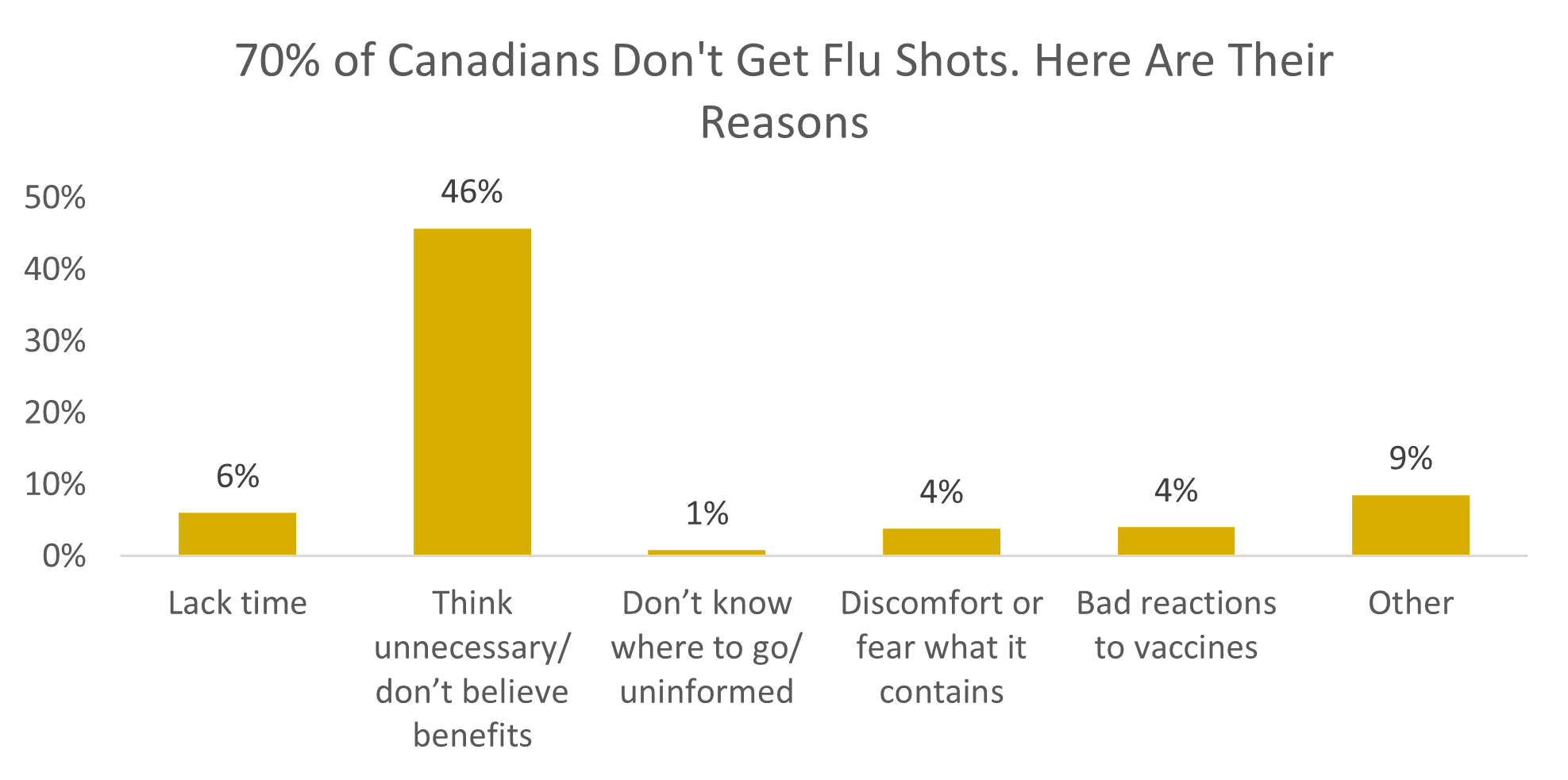
Of the 46% who don’t think the vaccine is necessary, 37% of Canadians aged 12+ believe flu shots are unnecessary and 9% don’t believe in the benefits of flu shots.
The strategy for getting Canadians to get COVID vaccines needs to be customized for each type of Canadian, depending on the reasons Canadians don’t want vaccines.
Vaccine Hesitancy Summary Profile
Who are these Canadians who think a vaccine is unnecessary? How can we reach and inform Canadians who don’t know where to get vaccines? Where can we find these groups?
| Lack Time | Think unnecessary/ Don’t believe benefits | Don’t know where to go/uninformed | Discomfort or fear what it contains | Bad reactions to vaccines | |
| Defining Demographics | · Children and young adults · Recent immigrants · Visible minority · High household income; |
· Age 25-64 · Common law families · Many self-employed and blue collar · Tenants · Average income; |
· Youth and young adults (age 15-34) · High school education · Sales and service occupation · Tenants · Recent immigrants · Visible minorities · Low income; |
· Lone parent families and singles · Average education · Blue collar and self-employed · Tenants · Recent immigrants · Visible minorities · Low income; |
· Common law families, separated, divorced or widowed · Middle age (35-64) · Average education · Non- or old immigrants · Average income; |
| Geographic Concentration in the Toronto CMA | · Mainly downtown and the Yonge Corridor | · Mainly downtown, Brampton, and in Richmond Hill | · Mainly in Midtown, Weston Road/HWY400 corridor, and East End | · Mainly in Midtown, Weston/HWY400 corridor, Brampton, and far East End. | · South end of Toronto, Brampton, Richmond Hill |
Consumer Profile: People Who Lack Time To Get Flu Shots
People who cite “lack of time” as a reason they did not get their flu shots generally:
- Are children and young adults, employees, recent immigrants, visible minority, high household income;
- Go to school, volunteer;
- Are light alcohol drinkers;
- Have health insurance with employer or association;
- Lost weight, changed diet, quit smoking, reduced stress level and took vitamins to improve their health;
- Think their barriers for improving health are: addiction to drugs/alcohol, too much stress, and too costly;
- Perceive they have very good health.
In the Toronto CMA (roughly the GTA), they mostly live downtown and along the Yonge Corridor:
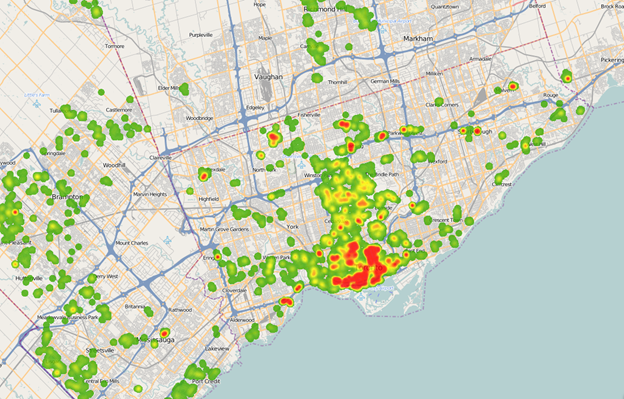
Consumer Profile: People Who Believe Flu Shots Are Not Necessary or Provide No Benefits
People who believe flu shots are not necessary or that they provide no benefits generally:
- Are age 25-64, common law families, employees and many are also self-employed. Blue collar, tenants, with average income;
- Are lighter smokers and alcohol drinkers;
- Live either in very low or very high density areas;
- Quit smoking and/or drink less alcohol to improve their health;
- Think taking vitamins is good for their health;
- Think their barriers for improving health are: addiction to drugs/alcohol, too much stress, too costly, and transportation problems;
- Have a weak sense of belonging to their local community;
- Perceive themselves to have excellent health.
In the Toronto CMA (roughly the GTA), they mostly live downtown, in Brampton, and in Richmond Hill:
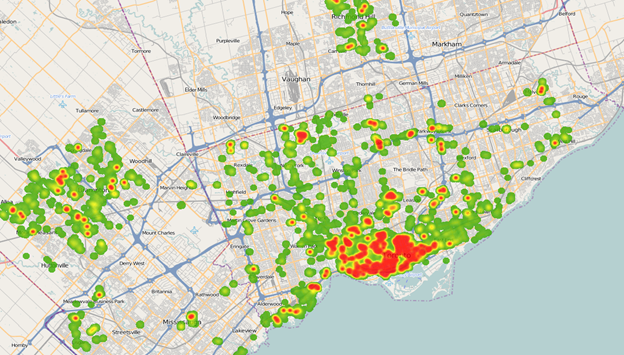
Consumer Profile: People Who Don’t Know Where to Go / Are Uninformed About Vaccines
People who don’t know where to go / are uninformed about flu shots generally:
- Are youth and young adults (age 15-34), high school education, sales and service occupation, tenants, recent immigrants, visible minorities, low income;
- Go to school, volunteering, or are looking for a job;
- Are heavy smokers and light alcohol drinkers;
- Have health Insurance through the government or associations
- Live in very high density areas;
- Increased exercise/sports activity, lost weight, and received medical treatment to improve their health;
- Think changing diet, quitting smoking, and taking vitamins is good for their health;
- Think barriers for improving health are: lack of will power, family responsibilities, work schedule, and weather problems;
- Are very dissatisfied with life and have a very weak sense of belonging to their local community;
- Perceive themselves to have fair health.
In the Toronto CMA (roughly the GTA), they mostly live downtown and are mainly concentrated around Midtown, Weston Road/HWY400 corridor, and the East End:
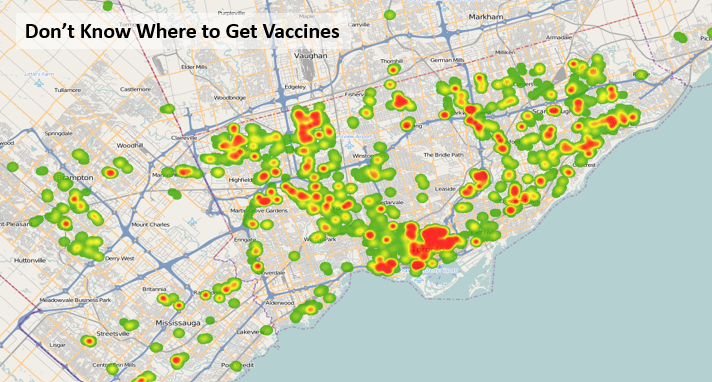
Consumer Profile: People Who Fear What Vaccines Contain or Have Fear of Discomfort
People who fear what vaccines contain or have fear of discomfort generally:
- Are lone parent families and singles, with an average education. They are blue collar and self-employed, tenants, recent immigrants, visible minorities, and low income;
- Are looking for a job, caring for children, and doing household work;
- Are heavy smokers and light alcohol drinkers;
- Live in very high density areas;
- Either have no health insurance or their own health insurance plan
- Increased exercise, sports, changed their diet, quit smoking, drank less alcohol, reduced stress, and received medical treatment to improve their health;
- Think changing their diet and taking vitamins are good for their health;
- Think barriers for improving their health are: lack of will power, family responsibilities, work schedule, too costly, transportation, and weather problems;
- Are dissatisfied with life and have a very weak sense of belonging to local community;
- Perceive themselves to have fair/poor health.
In the Toronto CMA, they are mainly concentrated in Midtown, Weston/HWY400 corridor, Brampton, and the far East End:
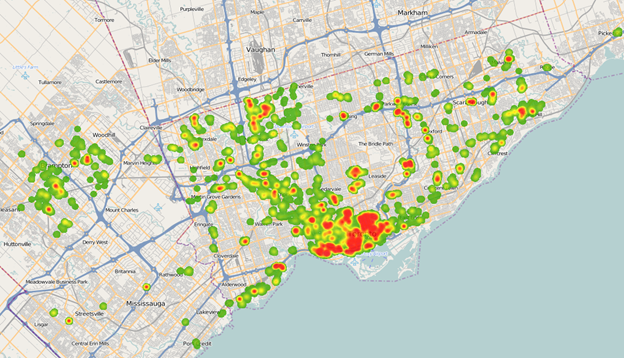
Consumer Profile: People Who Have Had Bad Reactions to Previous Vaccines or Flu Shots
People who have had bad reactions to previous vaccines or flu shots generally:
- Are common law families, separated, divorced or widowed, middle age (35-64), have an average education, and are non- or old immigrants, with an average income;
- Are employed, caring for children and others, doing household work, and are battling a long-term illness;
- Are heavy smokers and light alcohol drinkers;
- Have health insurance through the government or and employer;
- Changed their diet, quit smoking, drank less, reduced stress and received medical treatment to improve their health;
- Think reducing stress, changing their diet and taking vitamins are good for their health;
- Think barriers for improving their health are: their work schedule, addiction, disability/health condition, services not available in area, and transportation problems;
- Have an average satisfaction with life and a very weak sense of belonging to their local community;
- Perceive themselves as having fair/poor health, and being extremely stressed at work.
They are mainly concentrated in the South end of Toronto, in Brampton, and Richmond Hill:
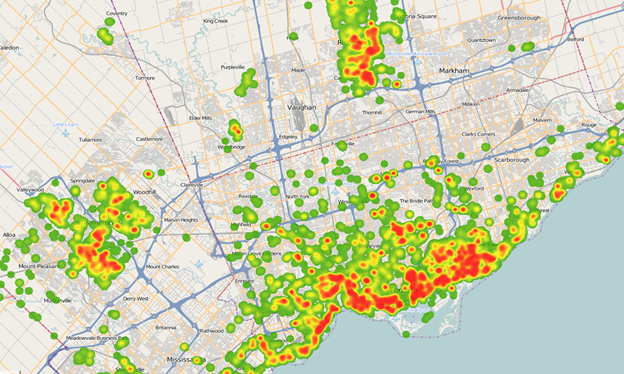
Hardest-hit communities least likely to get vaccinated
It turns out a lot of groups that don’t get the flu shot are the same as the groups that have high COVID case rates. E.g. those who don’t know where to go or fear the vaccines tend to be low-income, visible minorities, recent immigrants, and are overrepresented in the Highway 400/Weston Road area.
Many of those who believe flu shots are not necessary or provide no benefits also live in Brampton, where COVID case rates are some of the highest in the GTA. All these groups will hesitate to get the COVID vaccine. This makes these groups doubly vulnerable (high cases and more likely to hesitate to get vaccines). We need to make sure they get access to the COVID vaccine and the right messaging through the right media in the right places.
As we distribute vaccines, Public Health Units across Canada need to consider the most vulnerable, hardest-hit groups, especially since many of them will hesitate to get vaccinated.
Our COVID Hesitancy Score
Our COVID Hesitancy Score incorporates these reasons Canadians may not get COVID vaccines, as well as other key predictors.
Contact us to learn more about our COVID Vaccine Hesitancy Score, or COVID Risk Score, or if you have any questions.
